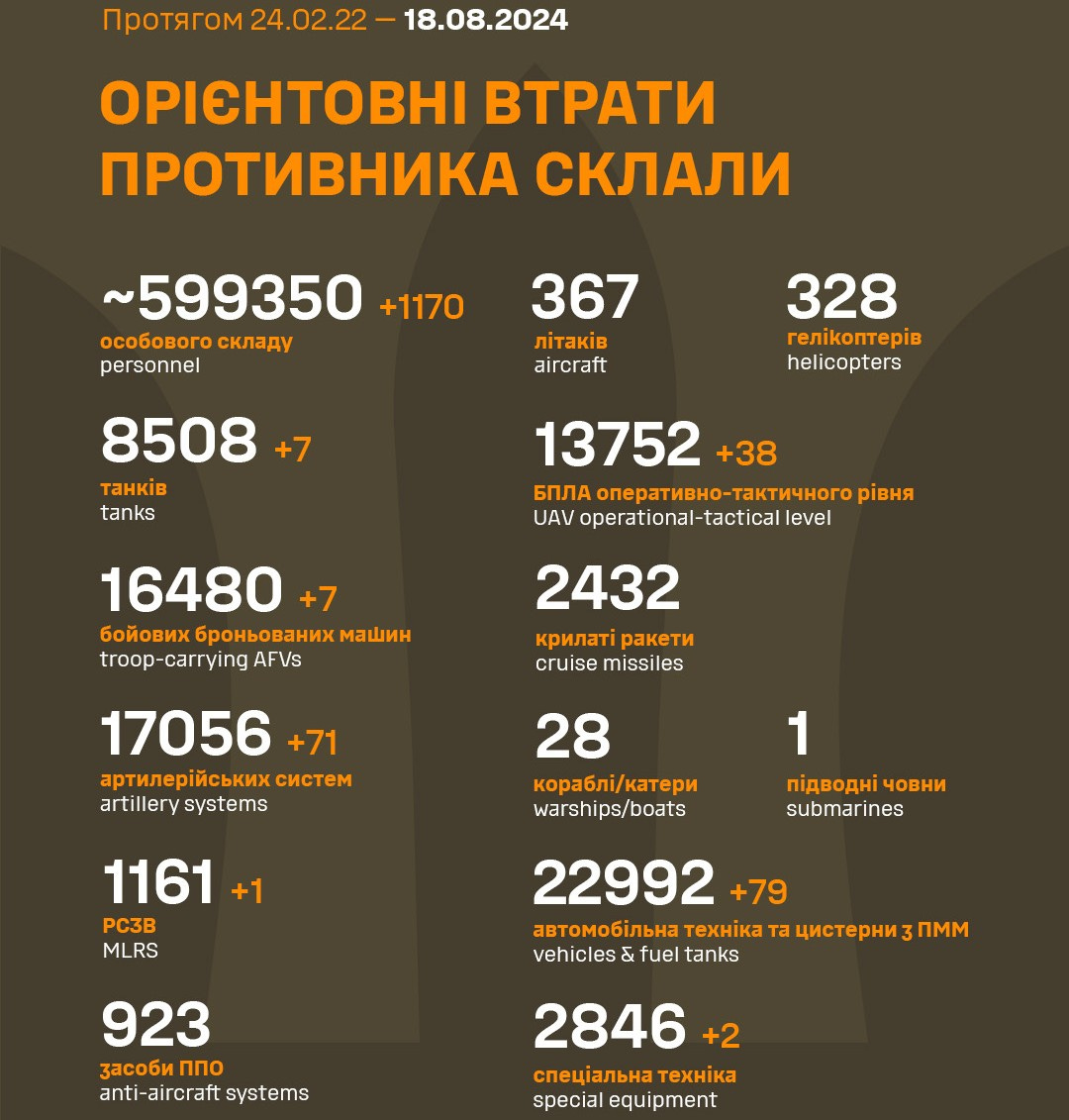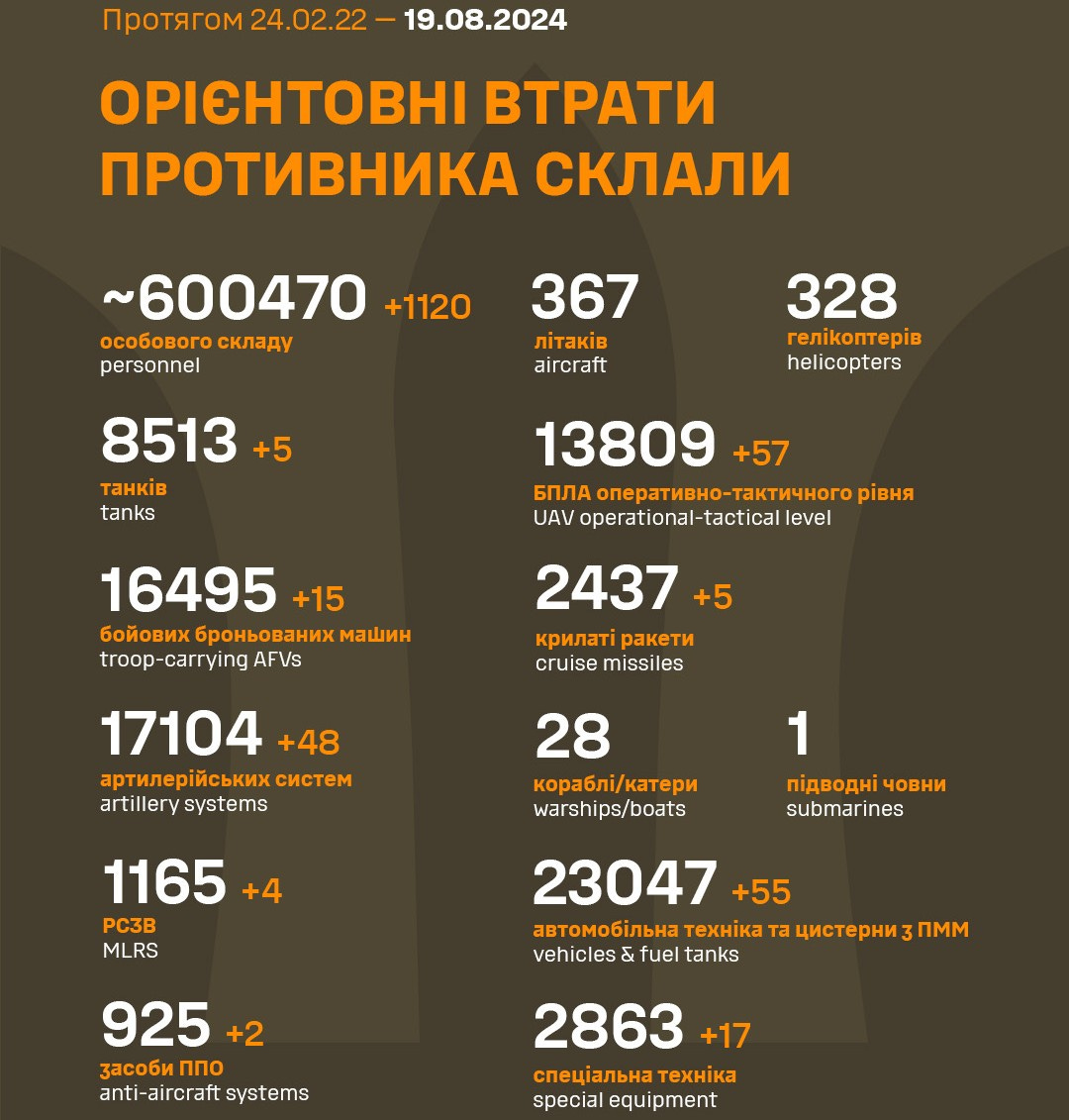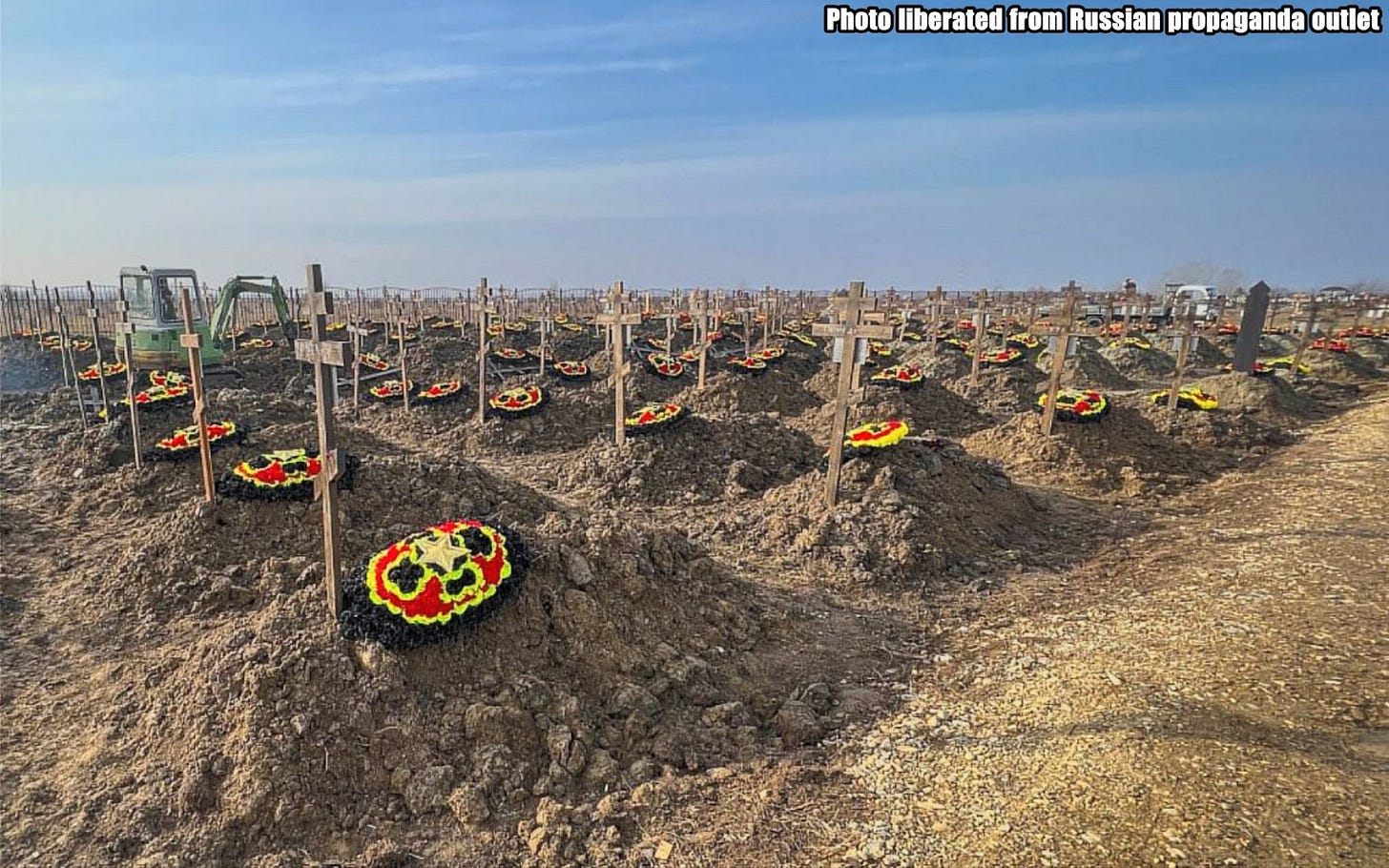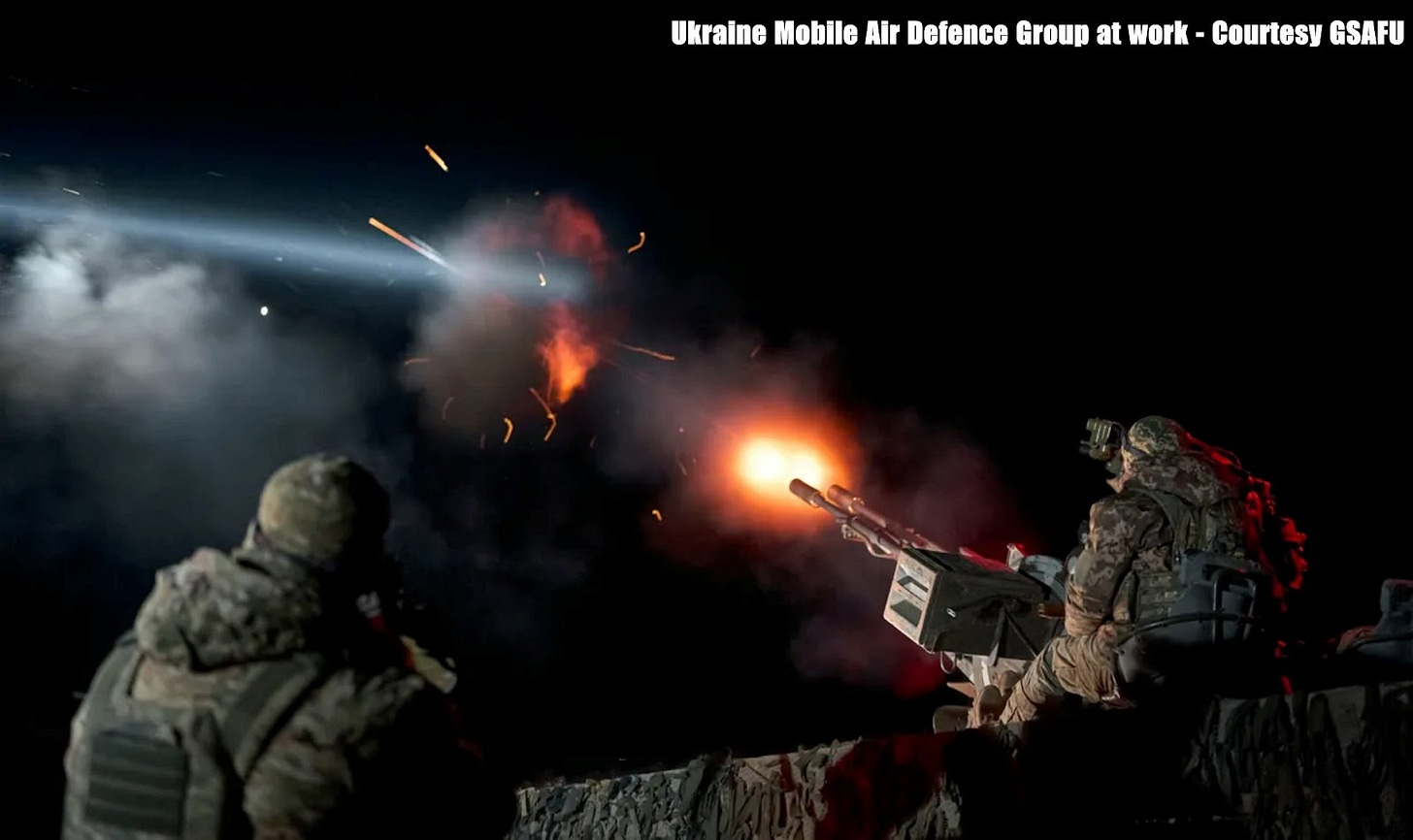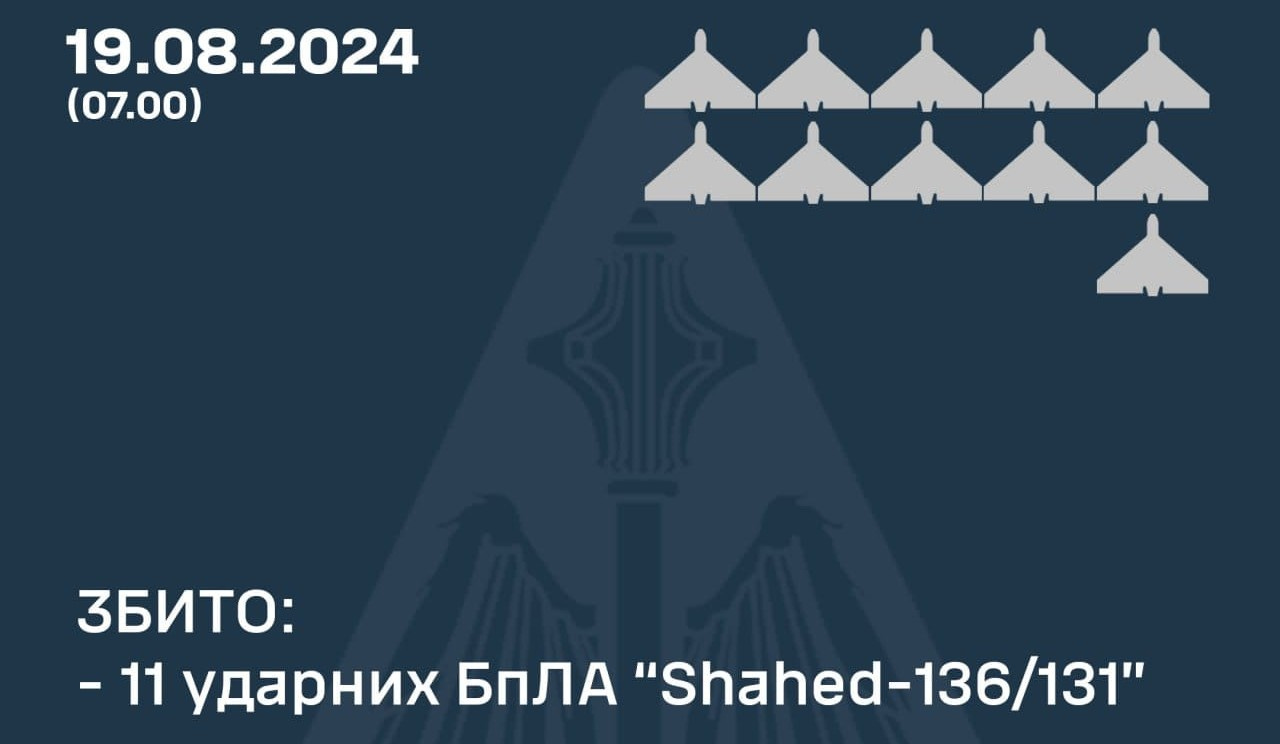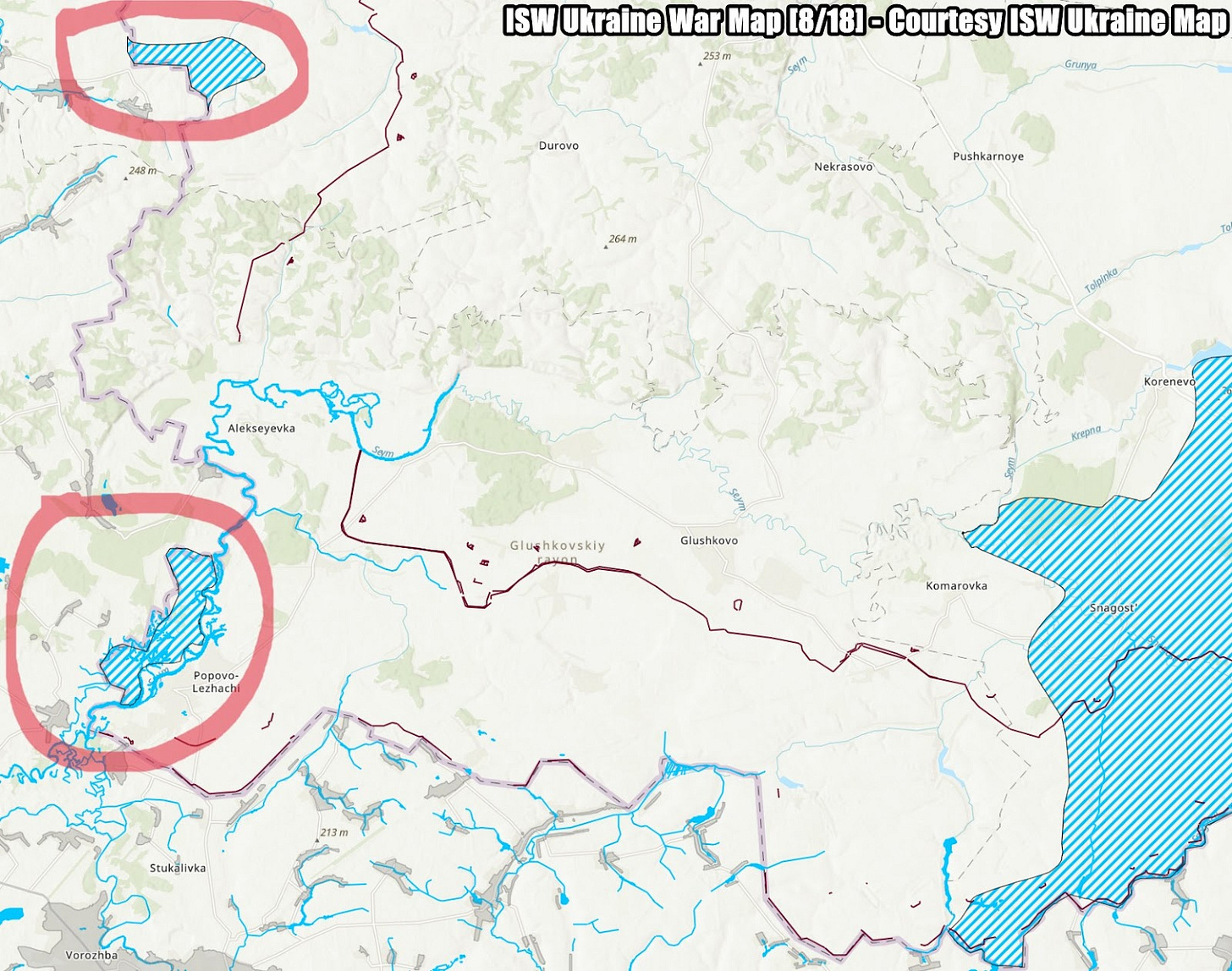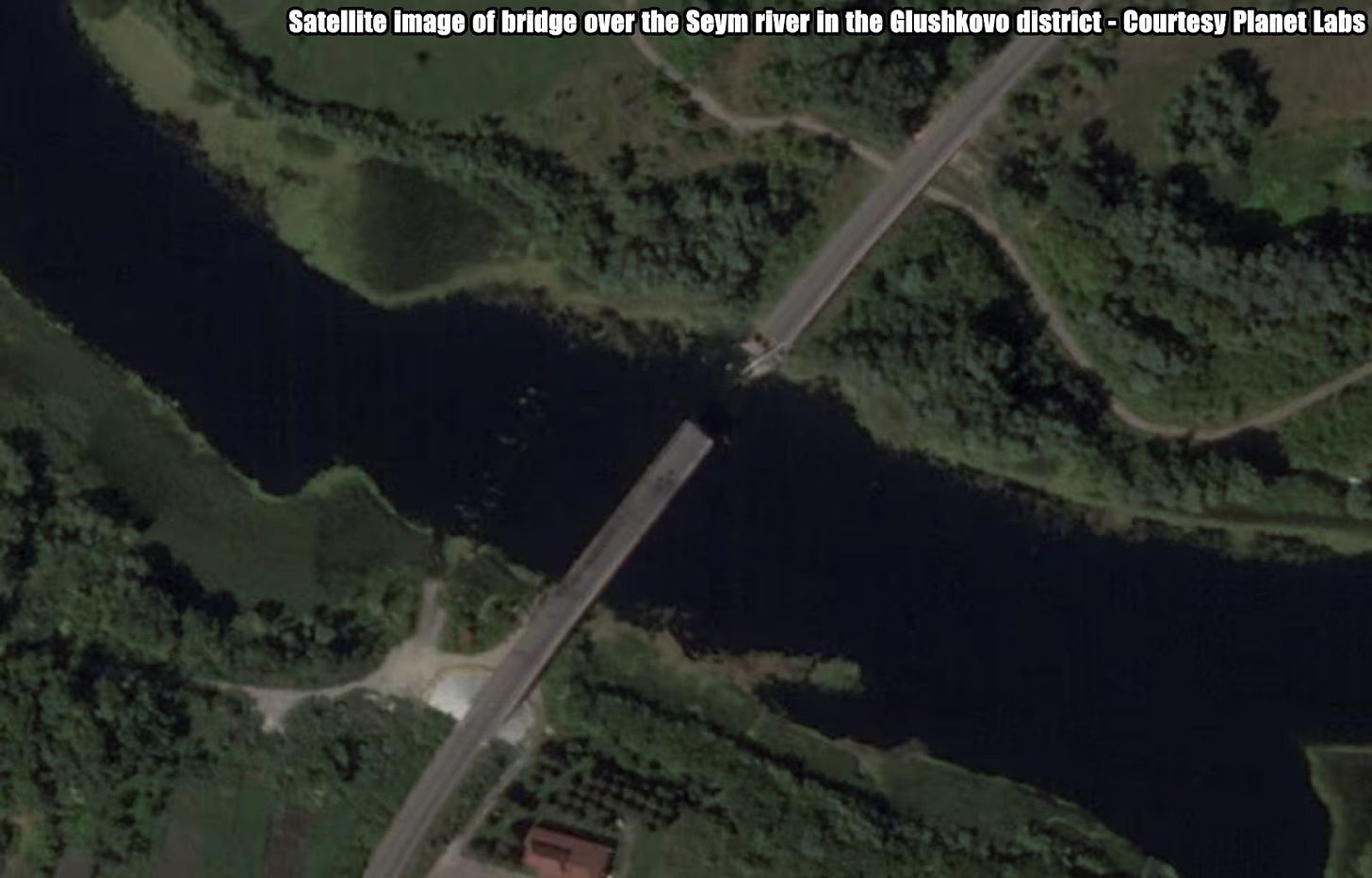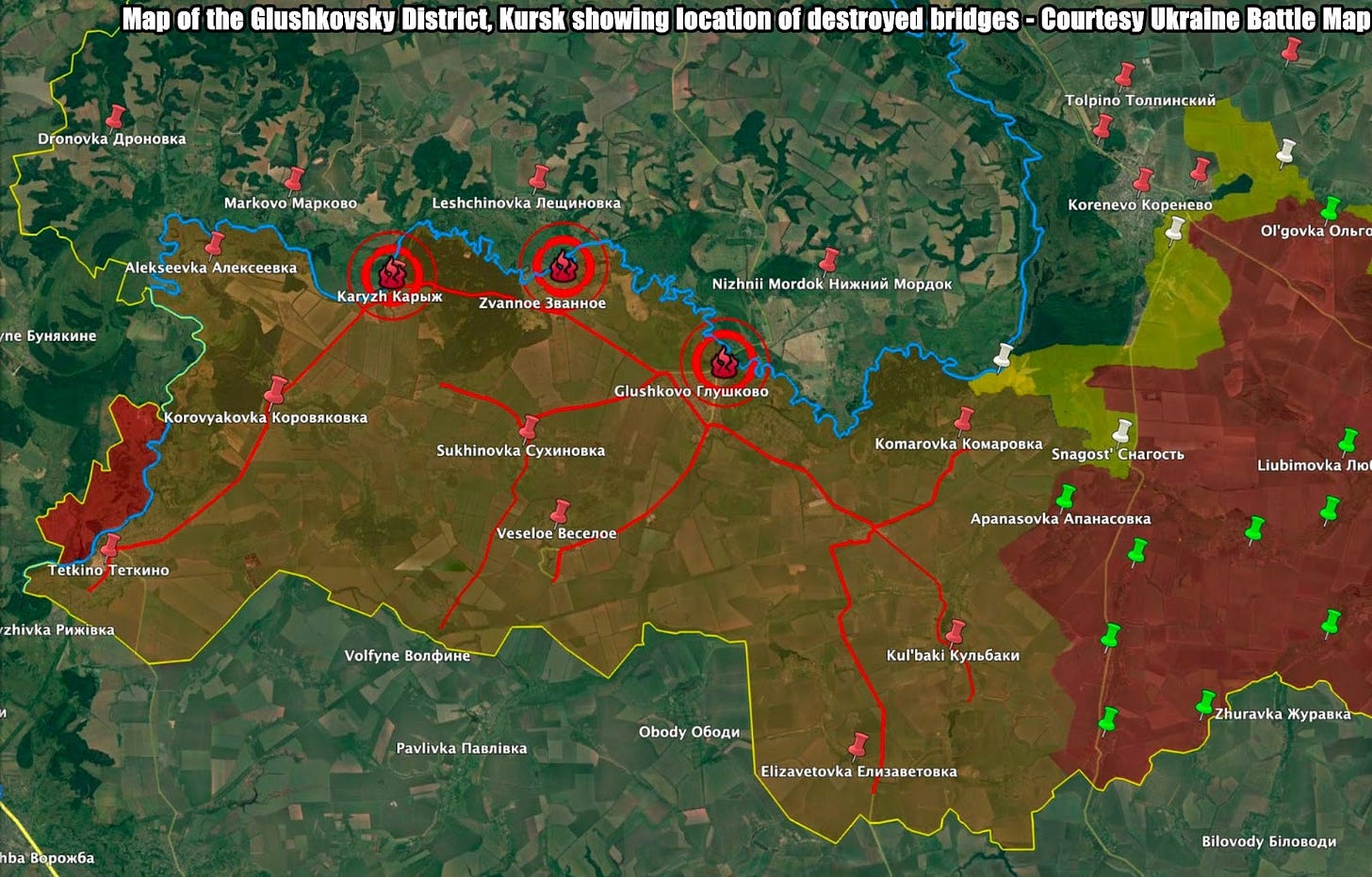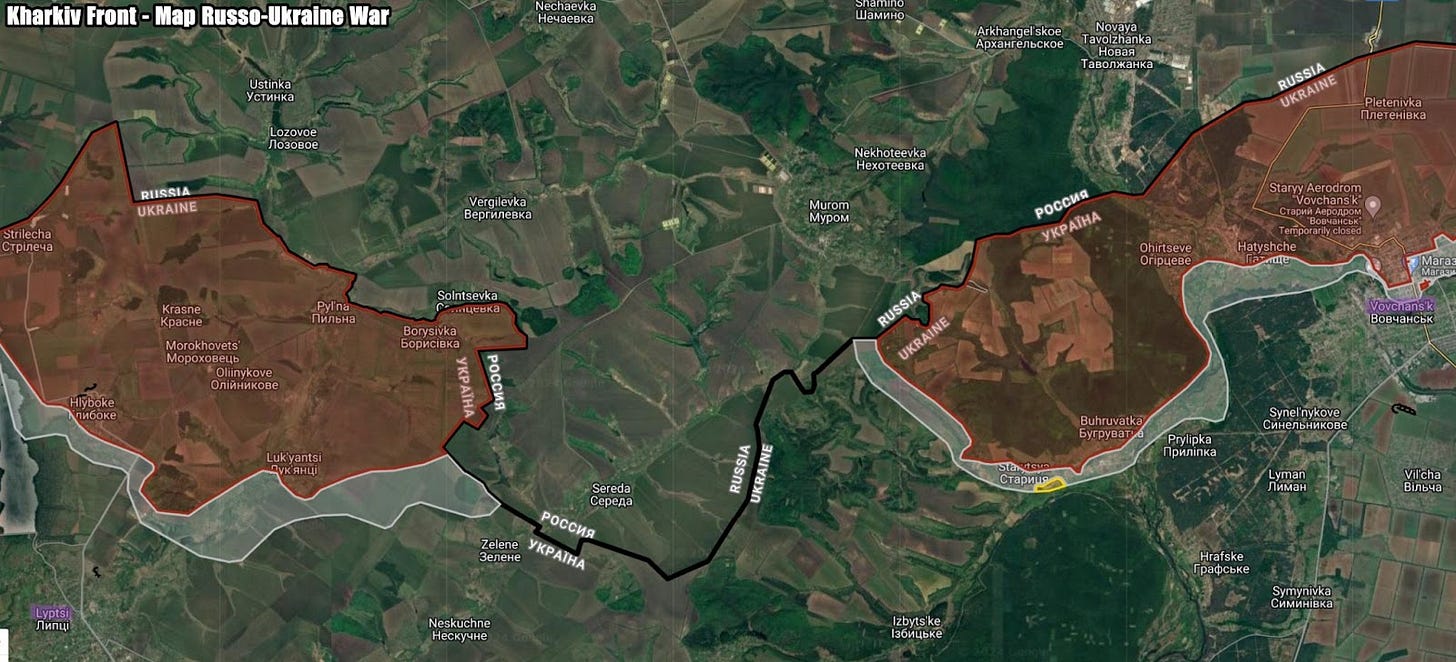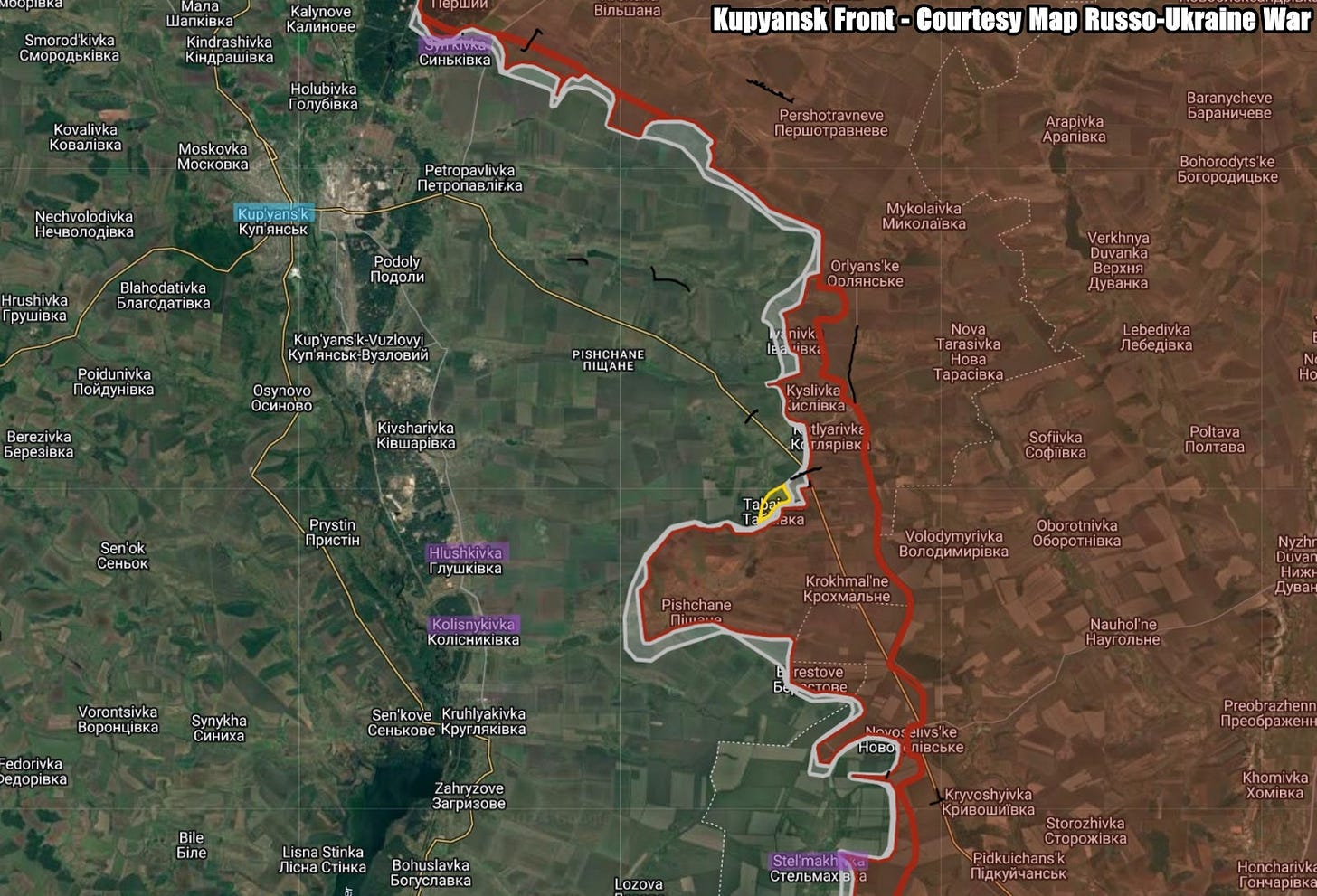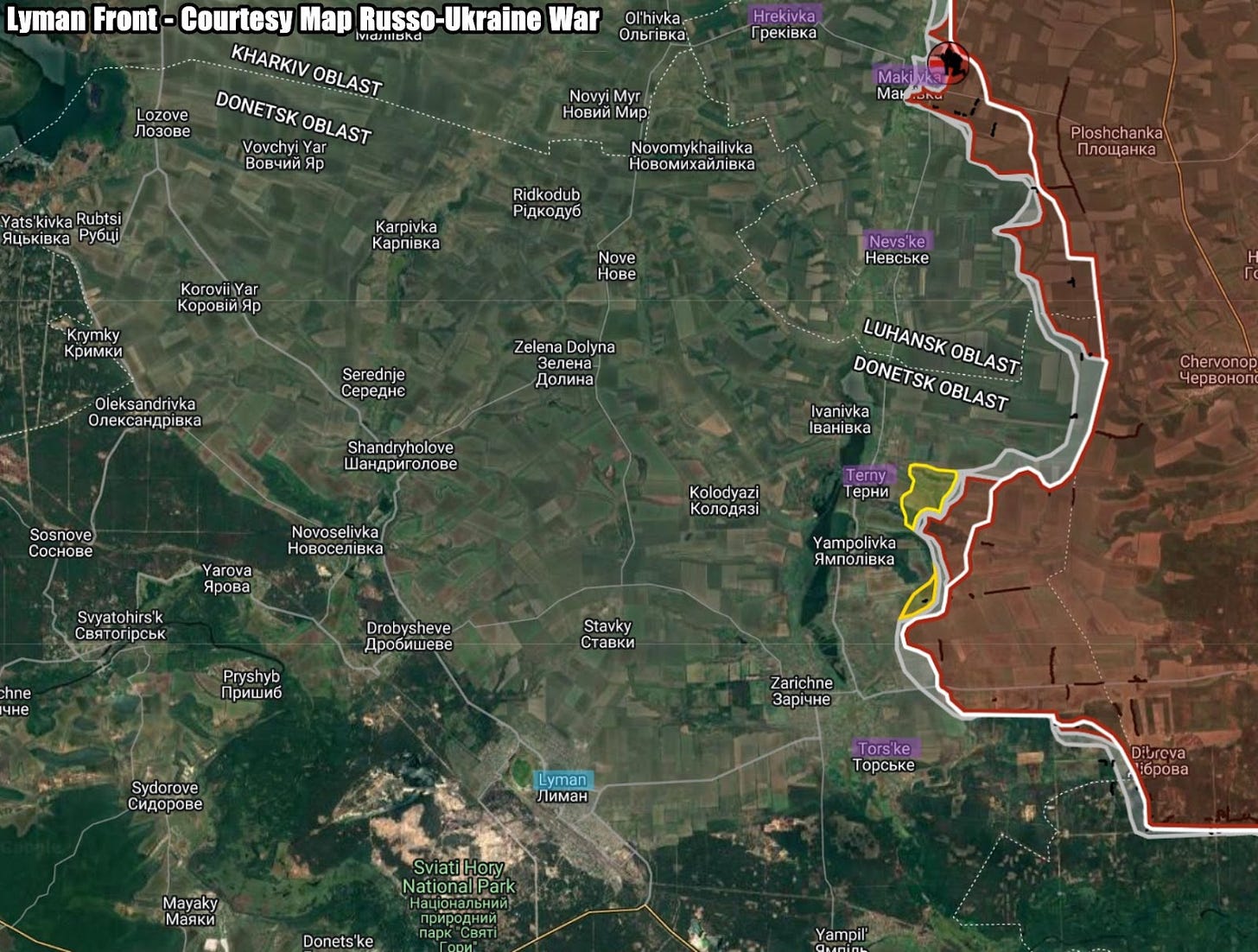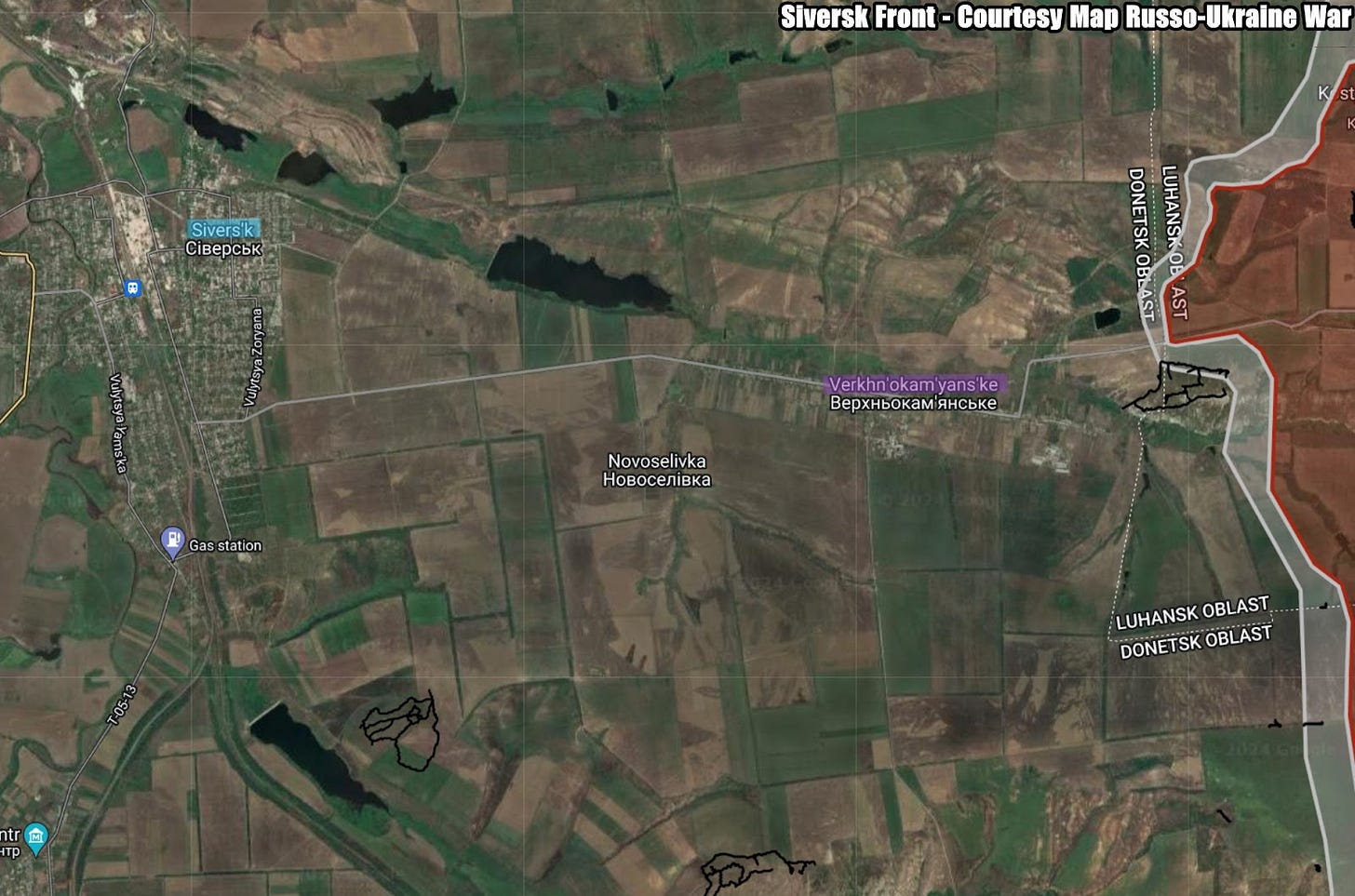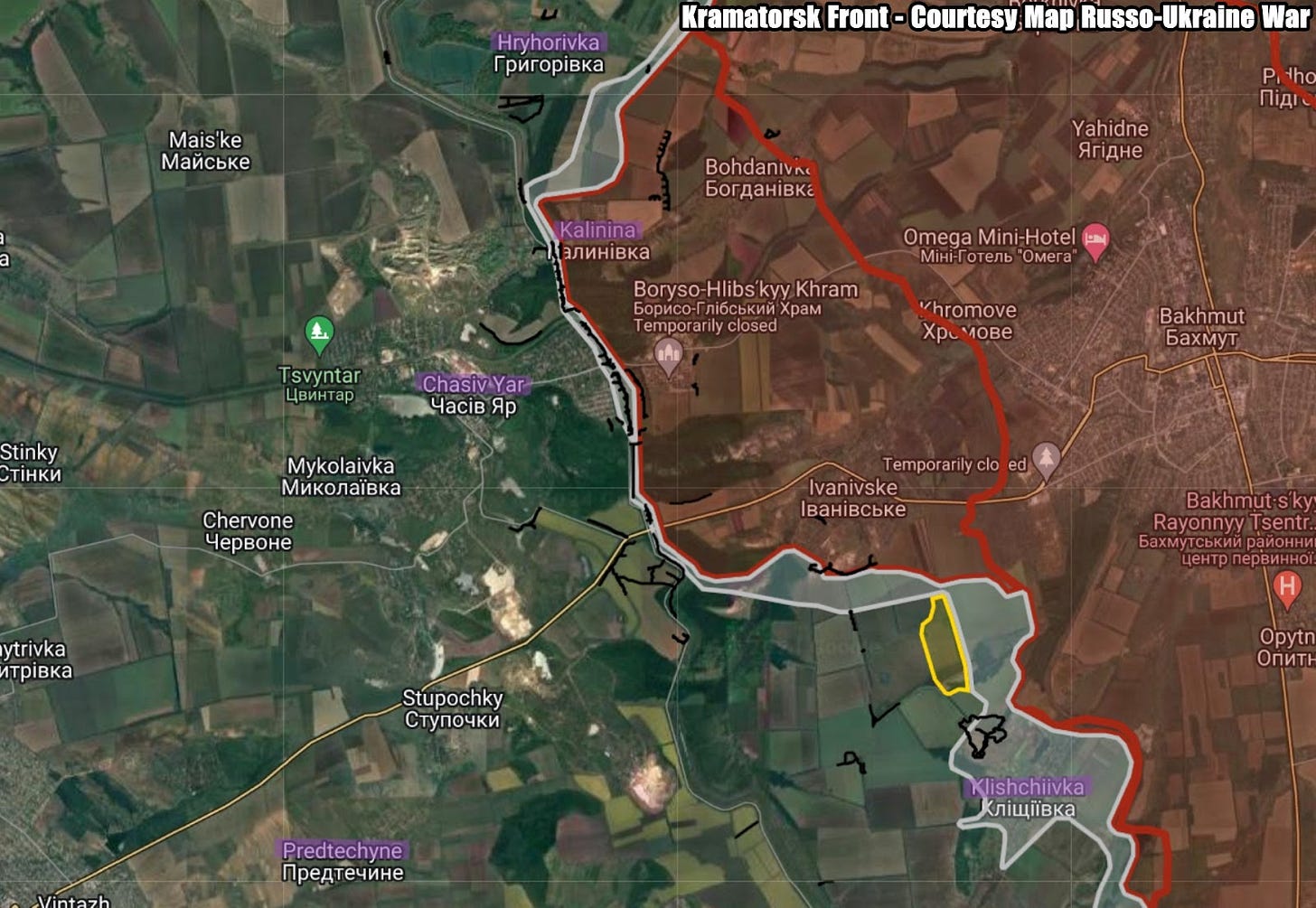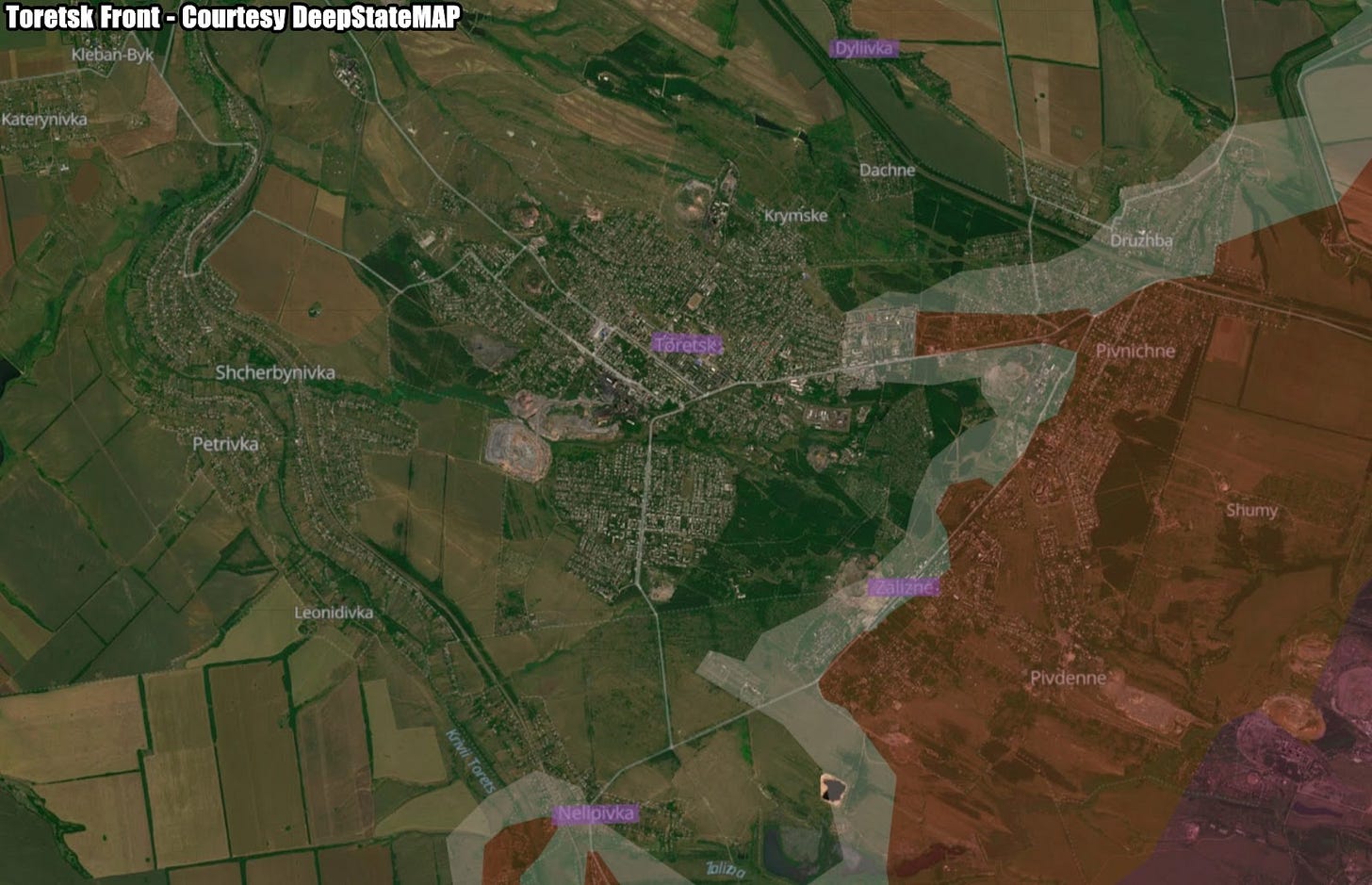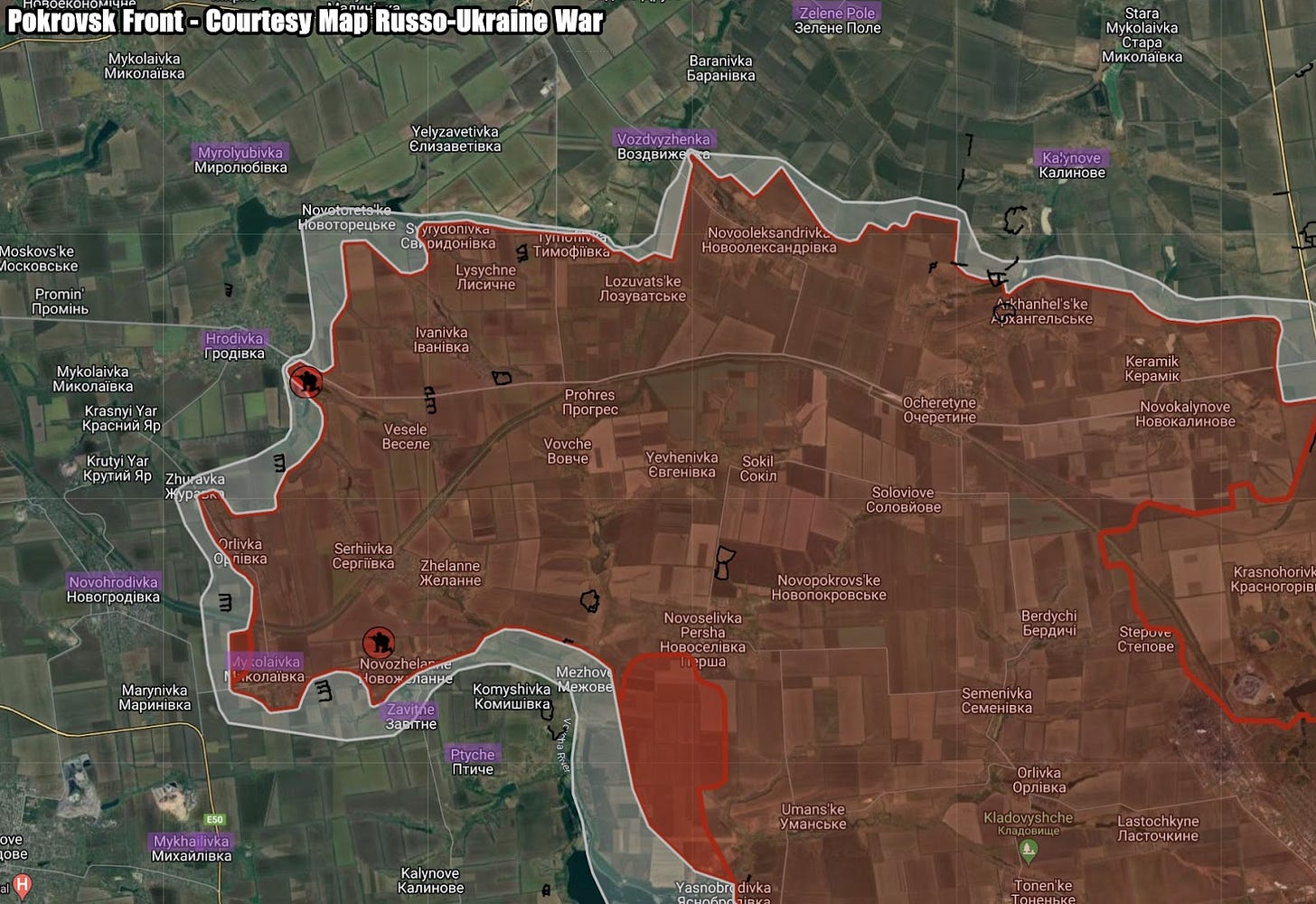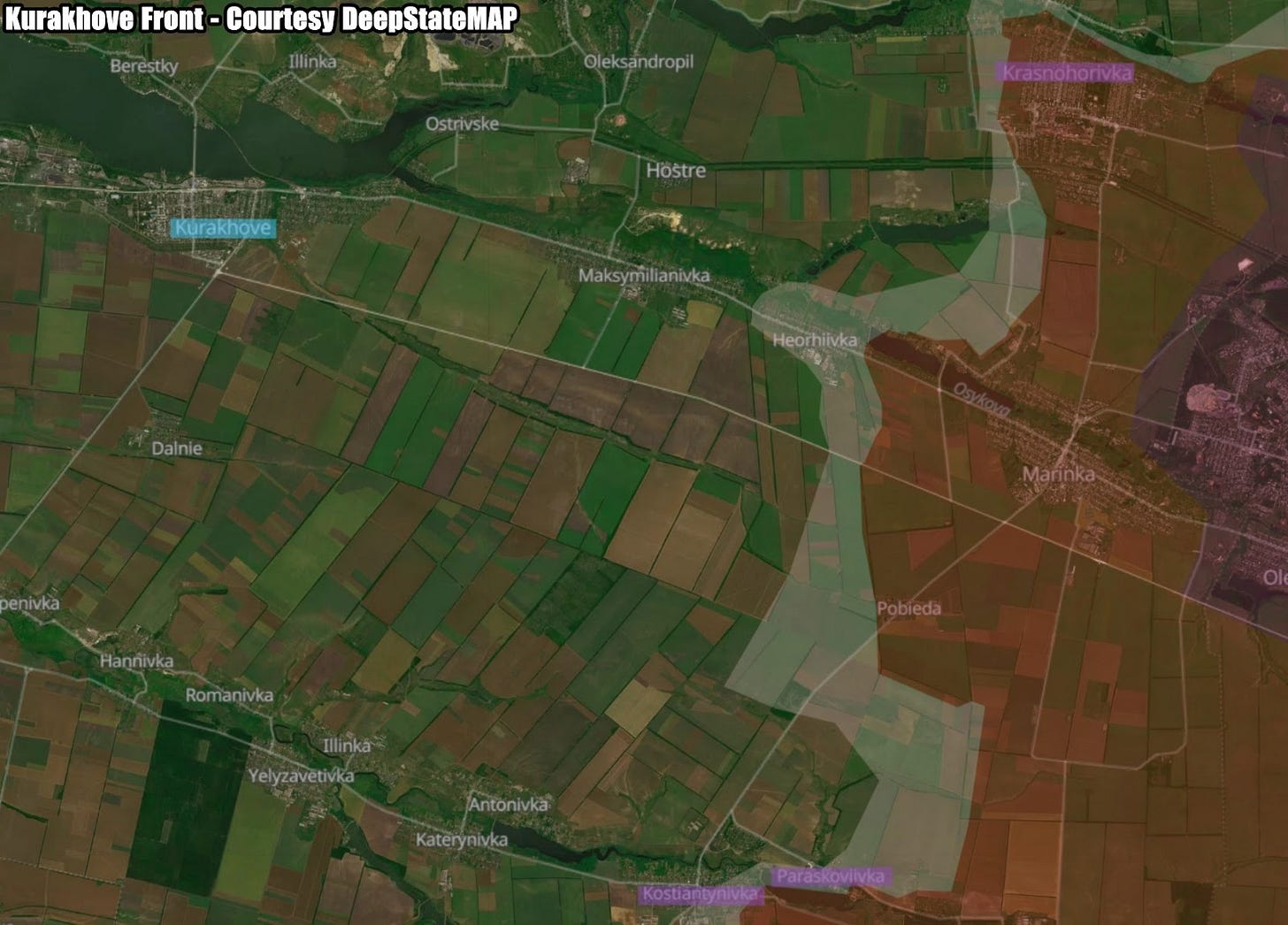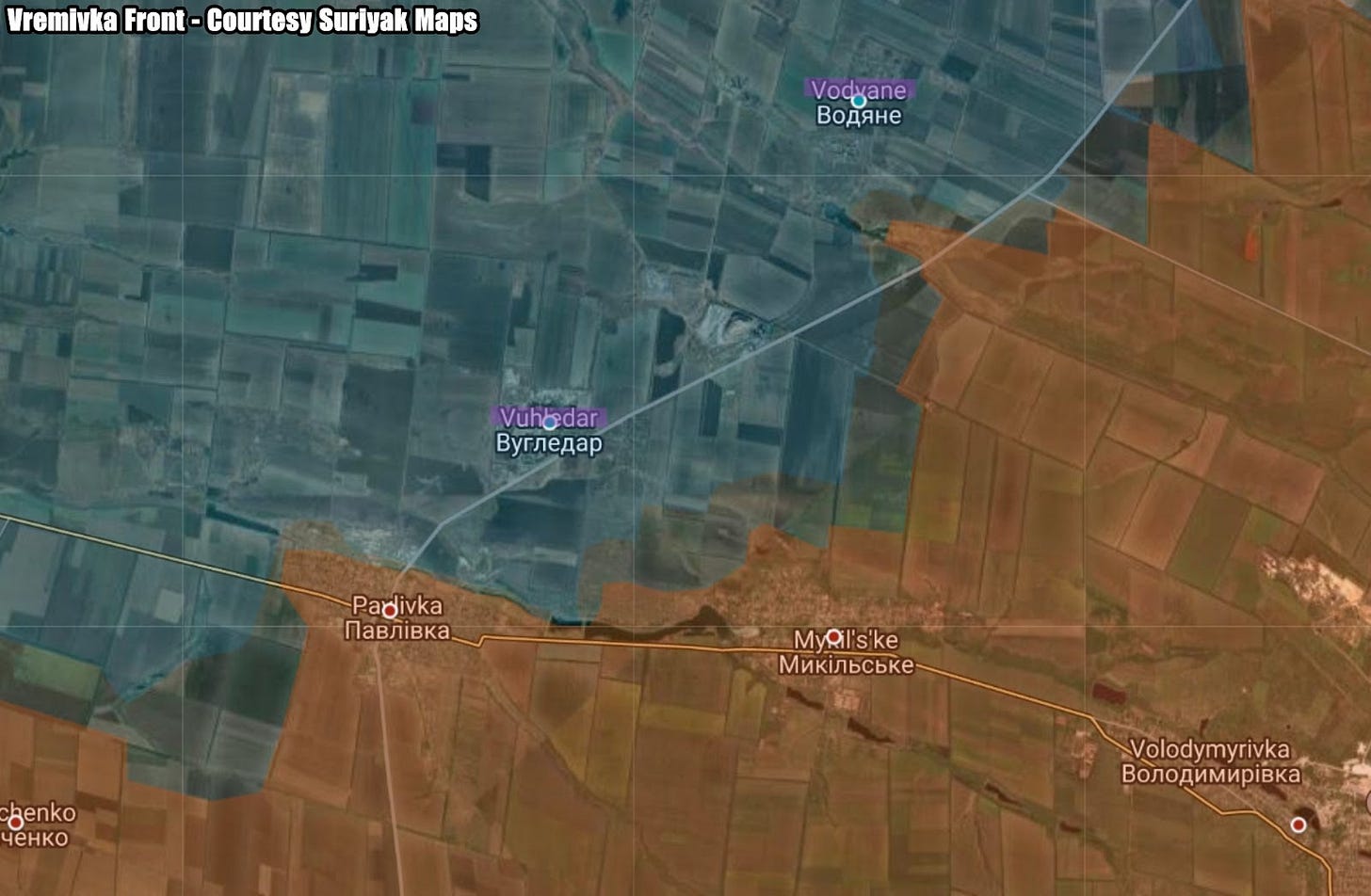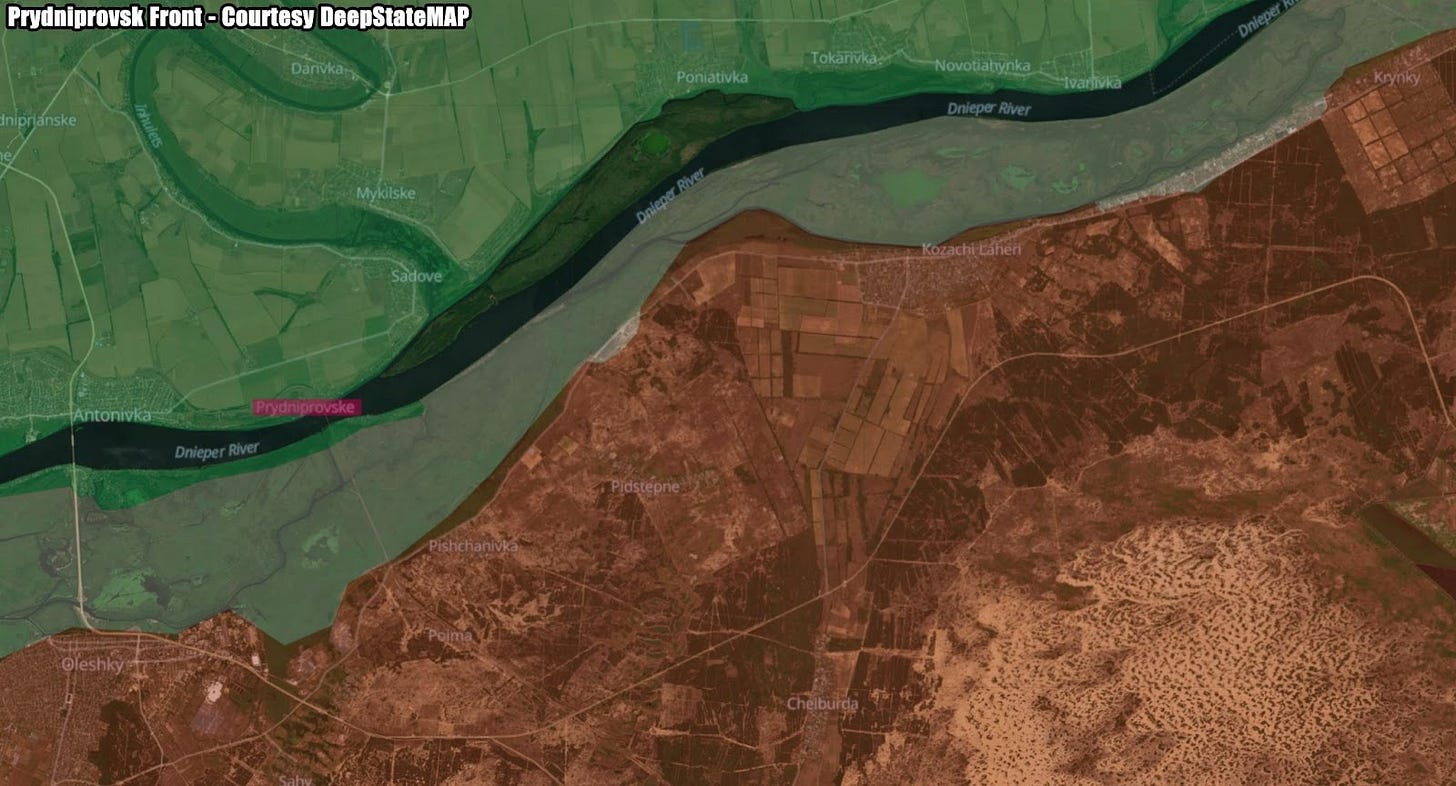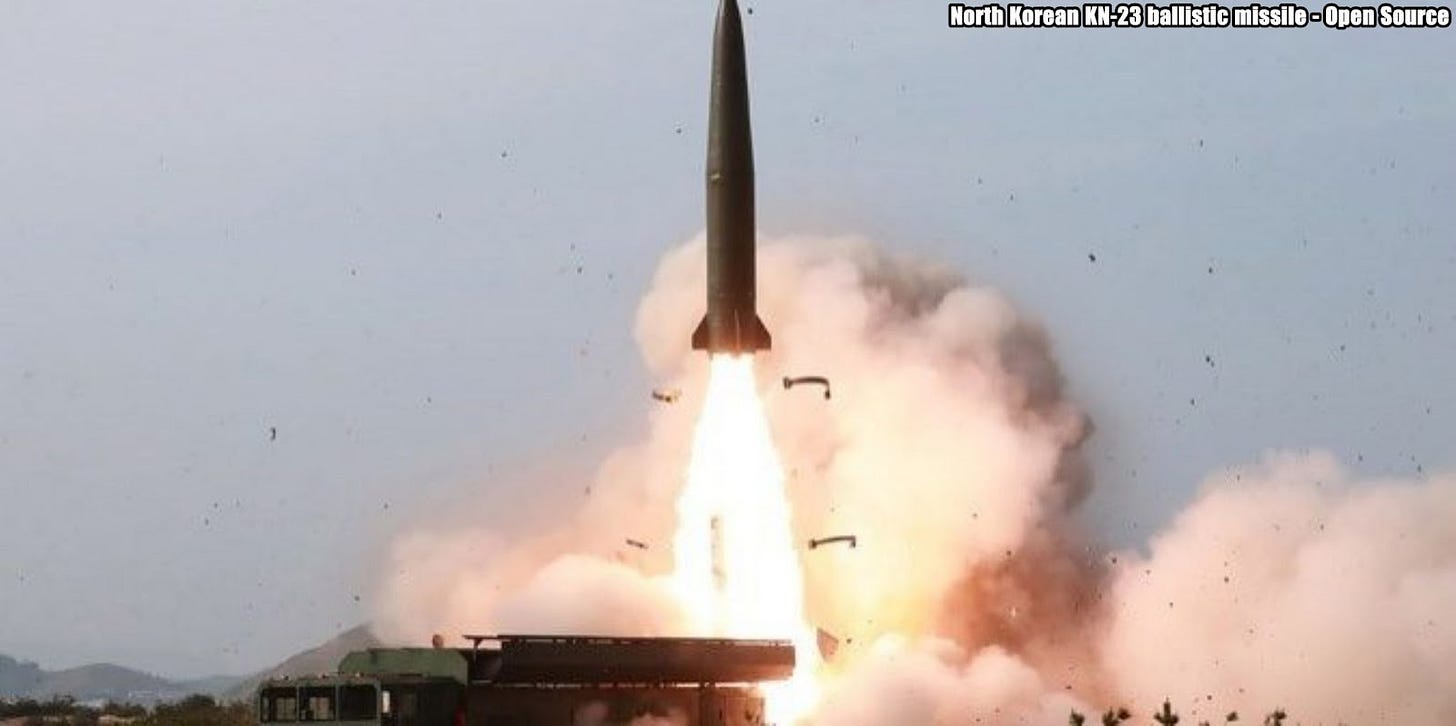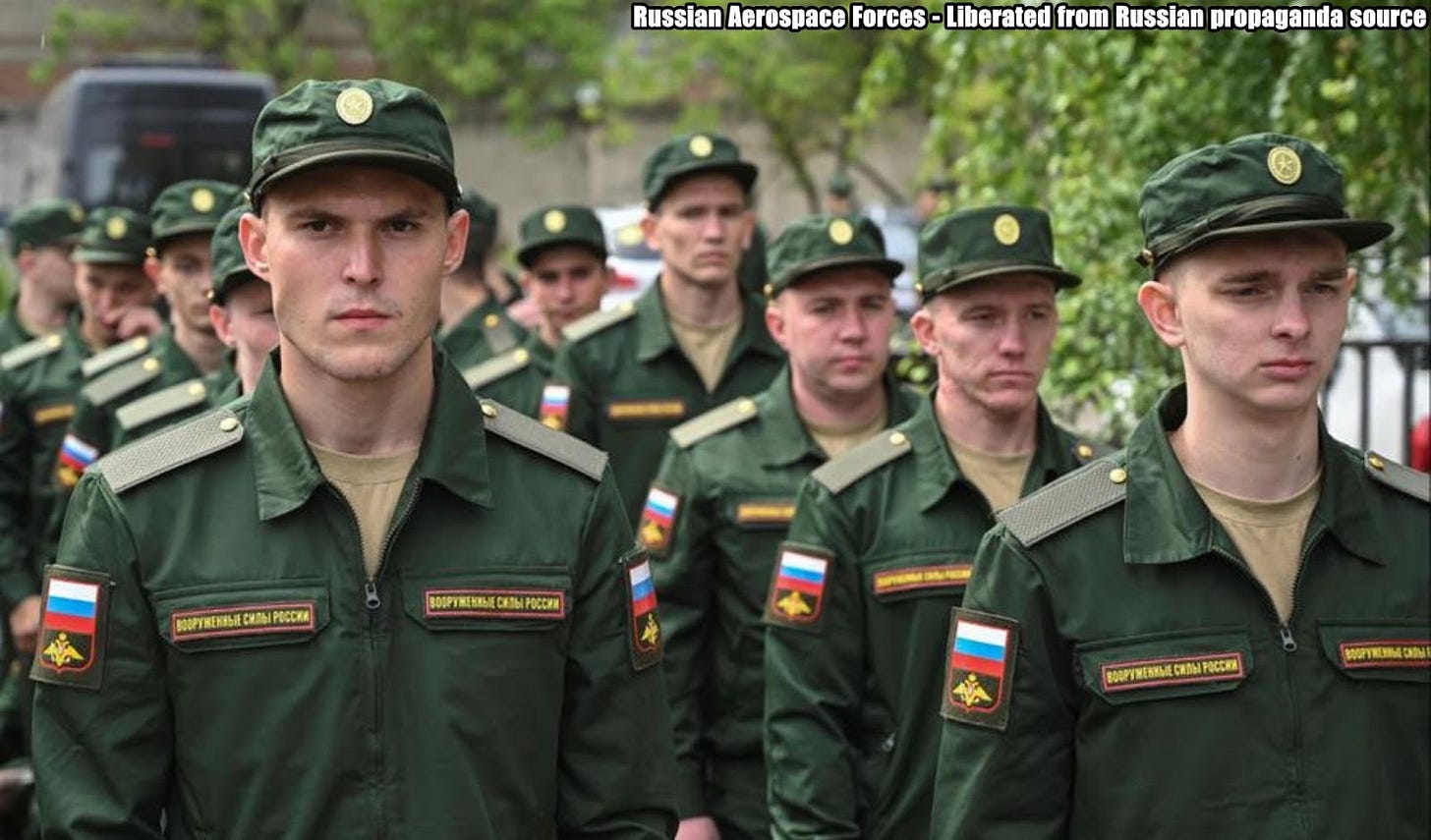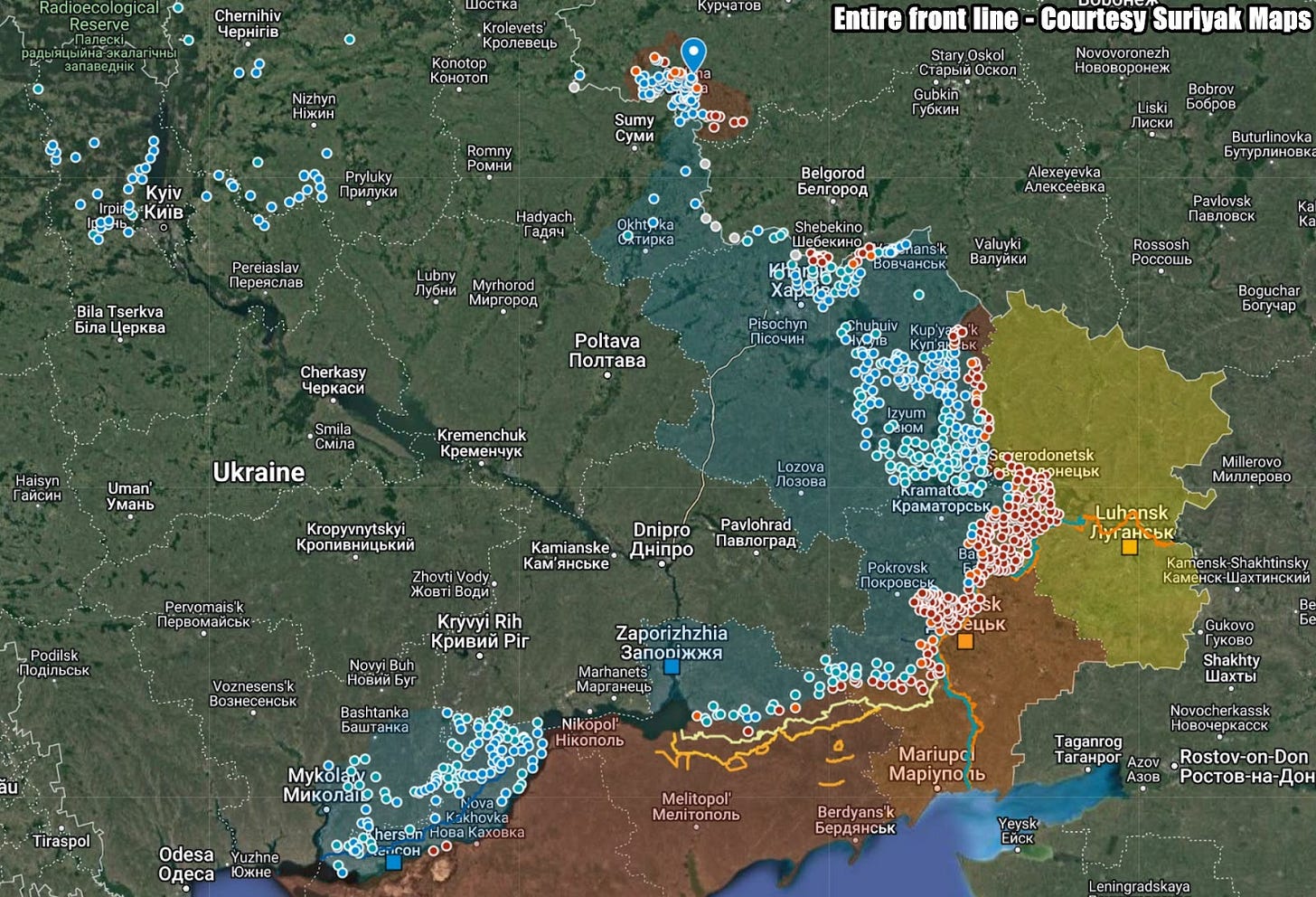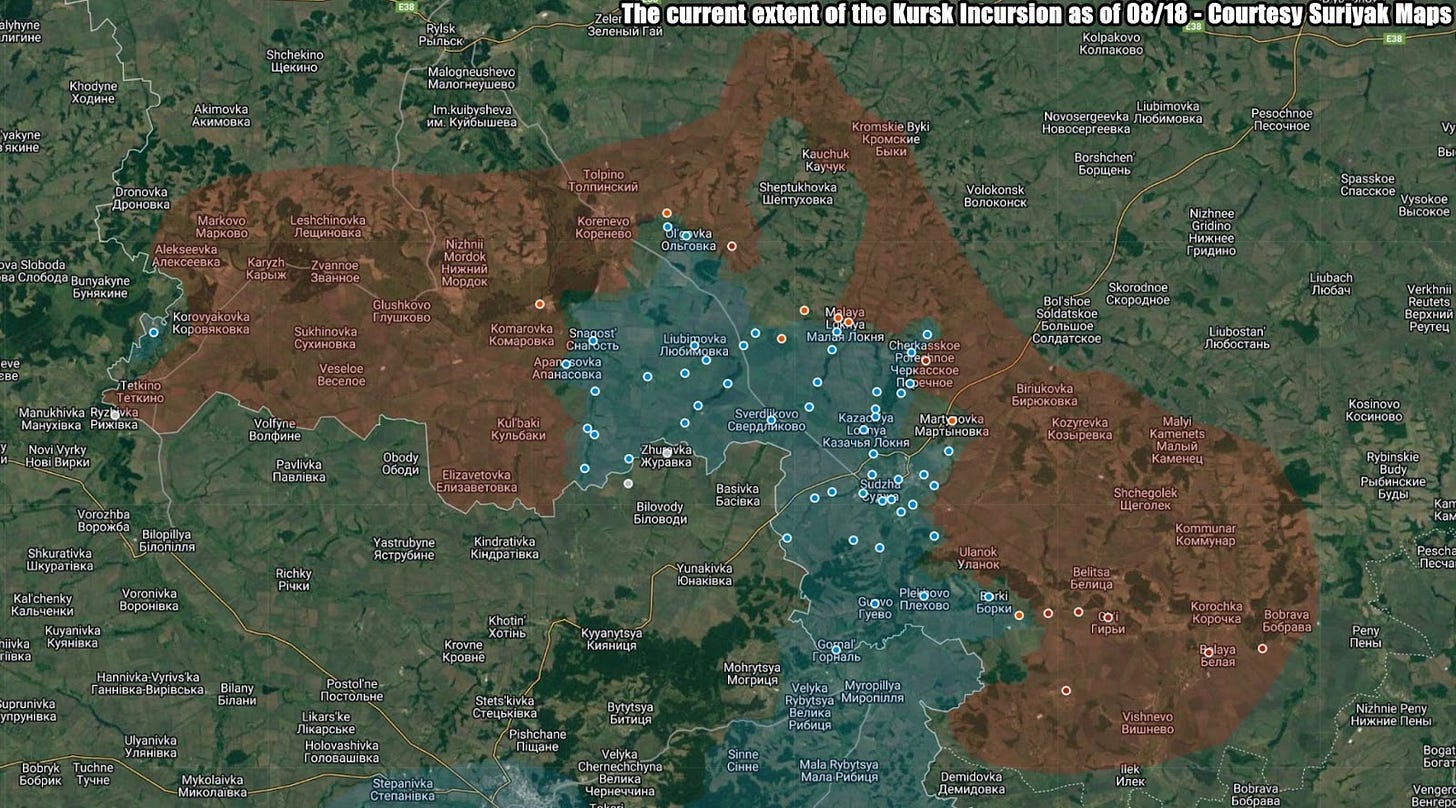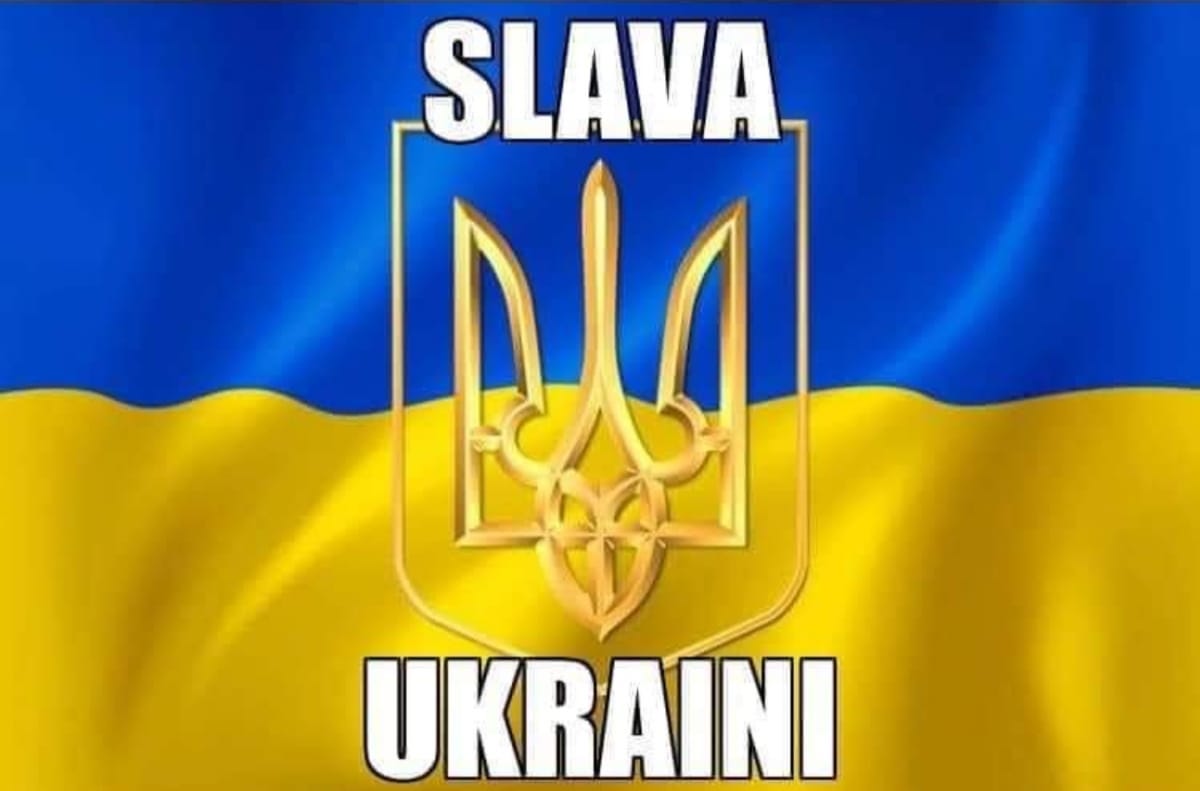Slava Ukraini! In early 2022 I began a Telegram channel aggregating news from a number of sources daily on the war in Ukraine. Since June 2023 I have provided a daily draft for the Ukraine War Brief Podcast collecting news from over 70 sources daily, much of which forms the basis of the script. While the Podcast is on hiatus I will make this Draft available here both on my own Substack and The People’s Media for those who wish to keep up with events on a daily basis.
Announcement - beginning this week and going forward, I will suspend publishing of the Draft on Sundays - Casualty figures and any major news will be reported in Mondays edition.
ALONG THE CONTACT LINE
GSAFU Morning Report
The General Staff of the Armed Forces of Ukraine in its Operational Information update at 22:00 on Aug 18 stated that day 997 of the full-scale invasion of the Russian Federation against Ukraine was about to begin.
During the past 48 hours, 208 combat engagements took place. Over the past 48 hours, the enemy carried out 10 missile strikes, 114 air strikes, 1,040 drone strikes and 5,888 artillery strikes across the positions of Ukrainian forces.
At the same time, Ukrainian soldiers continue to inflict losses in manpower and equipment on the occupying troops, exhausting the enemy along the entire front line and continue to disrupt the plans of Russian occupiers to advance deep into the territory of Ukraine.
-
General Staff: Russia has lost 600,470 troops since Feb. 24, 2022
Russia crossed another grim milestone in the past 24 hours. They have lost 600,470 troops since the beginning of its full-scale invasion of Ukraine on Feb. 24, 2022, the General Staff of Ukraine's Armed Forces reported on Aug. 19.
Air Force Daily Report
On the night of August 18, 2024, the enemy attacked with ballistic missiles from the Kursk and Voronezh regions, cruise and guided air missiles, as well as attack UAVs of the "Shahed" type (launch area of the Kursk region - Russian Federation).
A total of 16 means of air attack of the enemy were detected by the radio engineering troops of the Air Force:
- 1 "Iskander-M" ballistic missile;
- 2 KN-23 ballistic missiles;
- 2 Kh-59 guided air missiles;
- 3 cruise missiles (type to be specified);
- 8 attack UAVs "Shahed-131/136".
As a result of the anti-aircraft battle, the anti-aircraft missile forces of the Air Force, mobile fire groups of the Defense Forces of Ukraine and electronic warfare units shot down 13 aerial targets within Kyiv, Sumy and Poltava regions:
- 2 KN-23 ballistic missiles;
- 3 cruise missiles (type to be specified);
- 8 attack UAVs "Shahed-131/136".
The rest of the missiles, which did not get into the downed statistics, did not reach the desired targets. Previously, there were no casualties or casualties.
On the night of August 19, 2024, the Russian occupiers struck with 11 "Shahed" type attack UAVs from the direction of Kursk and Primorsko-Akhtarsk - Russia.
As a result of anti-aircraft combat by mobile fire groups of the Defense Forces of Ukraine, anti-aircraft missile units, aviation and EW means of the Air Force, all enemy UAVs were shot down in the Mykolaiv, Cherkasy, Vinnytsia, Kyiv, Dnipropetrovsk, Kharkiv, Sumy and Donetsk regions.
The Russian Border Incursion
Ukraine continues to advance in Kursk
The Institute for the Study of War (ISW), a US based think tank, in its Aug 18 Russian Offensive Campaign Assessment assessed that Ukrainian forces continued assaults throughout their salient in Kursk Oblast on August 18 and marginally advanced southeast of Sudzha.
A Russian milblogger claimed on August 18 that Ukrainian forces seized Troitskoye (south of Korenevo and roughly two kilometres from the international border) and advanced to Semenovka (north of Sudzha and roughly 24 kilometres from the international border)
A prominent Russian milblogger claimed that there are unconfirmed reports that Ukrainian forces entered Otruba (north of Tetkino and on the west [right] bank of the Seim River), and another Russian milblogger claimed that Ukrainian forces are operating near Tetkino.
Ukrainian Air Force Commander Lieutenant General Mykola Oleshchuk posted geolocated footage on August 18 showing Ukrainian forces conducting an airstrike against a bridge across the Seim River in Zvannoye (southeast of Korenevo), creating a large hole along the roadway.
Geolocated footage published on August 17 and 18 indicates that Ukrainian forces continue to operate throughout the maximalist claimed limit of Ukrainian advances within Kursk Oblast.
Grumpy Here - Of note in the latest ISW map are two smaller incursions in the far west of Kursk. Unconfirmed reports say that Russian forces have retreated and blown several bridges in the area.
Ukraine hits third bridge in in Kursk
Ukraine said on Monday it was achieving its goals in its two-week-old incursion into Russia's Kursk region after Moscow confirmed Ukrainian forces had damaged a third bridge after striking two others used to supply troops. Reuters reports.
Ukraine Battle Map on Twitter explains that Ukraine is confirmed to have destroyed the 3rd and final bridge across the Seym River connecting Russian forces to the Glushkovsky District, Kursk
Russia can no longer bring supplies or equipment into or out of ~640km2, roughly the area Russia took in the past year in Ukraine.
The Khortytsia operational-strategic group
(Responsible for the northeastern part of Ukraine. )
Kharkiv axis: There were 3 Russian attacks over the last day near Lyptsi and Vovchansk, 2 attacks are ongoing.
Kupyansk axis: The enemy carried out 16 attacks against Ukrainian positions near Sinkivka, Hlushkivka, Kolsnykivka and Stelmahivka. 4 engagements are still ongoing.
Lyman axis: Russia attacked 16 times unsuccessfully in the direction of settlements of Hrekivka, Makiivka, Nevske, Terny and Torske. 4 engagements are still ongoing.
Siversk axis: Russian forces carried out 1 unsuccessful assault in the vicinity of Verkhnokamianske.
Kramatorsk axis: Russian forces carried out 10 unsuccessful offensive actions near Hryhorivka, Kalinina, Chasiv Yar, Predtechyne and Klishchiivka.
Toretsk axis: There have been 16 Russian attacks over that last day with air support. All the efforts of the enemy were directed to the areas of Dyliivka, Toretsk, Zalizne and Nelipivka. 3 battles continue.
The Tavria operational-strategic group
(Responsible for the central-eastern and southeastern part of Ukraine.)
Pokrovsk axis: The greatest activity of the enemy today occurred in the Pokrovsk sector. The enemy conducted 33 attacks against Ukrainian defences in this area over the last day concentrating in the vicinity of Kalynove, Zelene Pole, Vozdvizhenka, Myrolyubivka, Hrodivka, Novohrodivka, Zhelanne, Mykolaivka, Zavitne, Ptyche and Muykhail 9 battles continue.
Kurakhove axis: Russian forces unsuccessfully tried to advance 6 times in the area of settlements Krasnohorivka, Paraskoviivka and Kostiantinivka.
Vremivka axis: In this sector the situation is under control, Russian forces made 4 Russian assaults against Ukrainian positions near Vodiane and Vuhledar, 1 battle is ongoing.
Orikhiv axis: The situation in this sector has not changed significantly.
The Odesa operational-strategic group
(Responsible for Kherson, Qırım, (also known as Crimea) and the Black Sea.)
Prydniprovsk axis: In this sector, over the last day, the situation has not changed significantly. Russian forces made 3 unsuccessful attempts to force Ukrainian units from their positions on the left bank of the Dnipro.
TEMPORARILY OCCUPIED TERRITORIES
Nothing to report.
THE HOME FRONT
Kyiv repels Russian aerial attack, North Korean ballistic weapons used in strike
Kyiv repelled a Russian missile and drone attack in the early hours of Aug 18, with city authorities saying North Korean ballistic weapons were used in the strike. No damage or casualties have been reported in the capital. The Kyiv Independent reports.
"This is the third ballistic missile attack on the capital in August, with a clear interval of six days between the attacks," Serhii Popko, the head of Kyiv Military Administration, said in a post on Telegram.
Popko added that according to preliminary information, Russian forces "most likely used KN-23, North Korean-made ballistic missiles."
Information released later by Ukraine's Air Force said one Russian and two ballistic missiles were used in the attack, as well as five cruise missiles and eight kamikaze drones.
It added that the two North Korean ballistic missiles, three cruise missiles and all eight kamikaze drones were intercepted by Ukraine's air defences.
The others "did not reach their desired targets" though no further information was given.
Air raid sirens rang out in Kyiv twice overnight though Popko said all the missiles and drones were downed on the approaches to the capital so no explosions were heard by those in the city.
Later on the morning of Aug. 18, Ukraine's State Emergency Service published photos of damaged residential buildings in the surrounding Kyiv Oblast and said rescuers were assisting people, but did not mention any casualties.
North Korea has long been shaping up as Russia's leading weapons supplier, reportedly providing Moscow with extensive military packages, including ballistic missiles and over 3 million artillery shells.
But the quality of the North Korean weapons is questionable – around half of the missiles fired at Ukraine by Russia have malfunctioned and exploded in mid-air, Reuters reported on May 7, citing Ukraine's Prosecutor General's Office.
Russian forces have intensified attacks against Kyiv in the summer of 2024. A mass drone attack launched on July 31 was the heaviest drone strike on the capital since the beginning of the year, according to the Kyiv City Military Administration.
RUSSIAN WORLD
Russians deploy Aerospace Forces into Kursk Oblast
Due to a manpower shortage, the Russian command has sent in soldiers from the Russian Aerospace Forces who were assigned to motorised rifle units to defend Kursk Oblast Russian “independent” media reports.
According to reports, Russian Aerospace Forces (VKS) soldiers formed a motorised rifle regiment in May or June as a border cover group. Mid-July was when the VKS infantry landed in the border territories, many weeks ahead of Ukraine’s Armed Forces offensive.
The publication's source stated that the unit consisted of engineers, mechanics, soldiers from the guard company, and a few flight crew officers.
They were assigned to infantry units, coming from various airfields: Ukrainka in the Altai Krai, Belaya in Irkutsk Oblast, and Engels in Saratov Oblast. Heavy Tu-22M or Tu-95 bombers are stationed at each of these airbases, from which missiles are fired into Ukrainian cities.
Additionally, there are personnel from Voronezh radar stations, staff from special VKS warehouses, and servicemen from one of the Russian cosmodromes. These stations are positioned to alert people in the event of a nuclear attack near Russia's borders.
Russia continues to redeploy troops from elsewhere in theatre to Kursk
The Institute for the Study of War (ISW), a US based think tank, in its Aug 18 Russian Offensive Campaign Assessment stated that The Ukrainian incursion into Kursk Oblast continues to force Russia to redeploy forces from elsewhere in the theatre, and likely subsequent phases of fighting within Russia will require more Russian manpower and materiel commitments to the area.
WSJ's source stated that Russian forces redeployed an understrength brigade from Donetsk Oblast, possibly referring to elements of the Donetsk People’s Republic [DNR] "Pyatnashka" Brigade, which ISW observed arriving in Kursk Oblast around August 8 alongside other smaller Russian irregular units from Donetsk Oblast.
Russian forces have redeployed additional forces to Kursk Oblast since the first week of the Ukrainian incursion and have likely redeployed more than 5,000 personnel to Kursk Oblast overall.
NEWS WORLDWIDE
Kyrgyzstan's major bank suspends transfers via sanctioned Russian banks
In a further sign that Central Asian countries are abandoning the Russian camp, MBank, one of the largest banks in Kyrgyzstan, has suspended money transfers through Russian banks affected by sanctions, according to the bank's Some commercial banks in Kyrgyzstan, including Mbank, partially suspended transfers with Russia in June. The Times of Central Asia reports .
In June, the U.S. Treasury Department's Office of Foreign Assets Control (OFAC) announced a new round of sanctions, targeting Russian financial institutions that serve as intermediaries in dollar trading on the Russian foreign exchange market.
"Money transfers through Russian banks, including Sberbank, Tinkoff, and MTS, have been suspended in both directions. This service is unavailable indefinitely," the bank's statement read.
Incoming transfers will be conducted through banks that have not been affected by sanctions on ruble details, according to MBank.statement published on Aug. 17.
Western countries have imposed extensive economic restrictions against Moscow over its full-scale invasion of Ukraine, seeking to curb its state revenue and prevent it from obtaining key technologies needed for the war effort.
Russia has sought to dodge these sanctions via various third-party entities in China, Central Asia, Turkey, and the United Arab Emirates.
India's Modi to visit Ukraine
Indian Prime Minister Narendra Modi will visit Ukraine on Friday after an invitation came from President Volodymyr Zelenskyy. DW reports.
"This is the first visit of the head of the Indian government to our country in the history of bilateral relations," the Ukrainian presidential office said in a statement on Telegram.
Modi will also visit Poland as part of his trip.
The announcement of the planned visit to Ukraine and Poland comes just weeks after Modi visited Russian President Vladimir Putin in Russia, drawing criticism from Kyiv after pictures emerged of him hugging his host at Putin's country residence.
Western allies deliberately left in the dark about Kursk incursion plans
General Syrsky kept his plans under wraps, sharing them only with a tight group of generals and security officials. The Economist reported in an article on Aug 18.
He spoke to the president on a one-on-one basis, without his staff. The army’s intelligence did much of the reconnaissance, rather than leaving it to hur, Ukraine’s military intelligence agency, which was included only at a late stage.
Western allies were also deliberately left in the dark, claims the source. “Syrsky had two previous operations undermined by the West. One was leaked to the Russians, and on another occasion, we were instructed to abort.” Limiting communication to a need-to-know basis enabled the Ukrainians to launch their attack before the Russians grasped what was happening. “They realised something was afoot but likely assumed we would need American approval for such a daring operation.” Having been presented with a fait accompli the West did not object.
General Syrsky confused the enemy by concealing the arrival of his most battle-hardened divisions. Reinforcements were brought to the forests near the border under the pretext of defending against a supposed Russian attack on Sumy. At the same time, a narrative appeared in Ukrainian media about an imminent Russian invasion. “The rotation happened about a week and a half before the start of Kursk operation,” recalls Serhiy. “The Russians continued to believe that we were simply defending the border.”
The soldiers themselves started to suspect something big was happening in early August, when they were suddenly issued with equipment: new helmets with integrated headphones, new assault rifles. They did training exercises on mock-ups later understood to represent Russian villages. The 80th brigade began preparing for a second-wave attack. General Syrsky saved most of his attacking forces for this second line, which may be why Russia initially thought the breakthrough was not too serious. The soldiers say they didn’t believe their commanders when he told them about the plans. “We laughed,” recalls Private Serhiy. “We joked that it wasn’t April 1st. The commander just smiled, knowing we had no idea what was awaiting us.”
MILITARY & TECH
Germany delivers third IRIS-T SLS air defence system, other aid to Ukraine
Germany has supplied a new IRIS-T SLS air defence missile system, 14,000 rounds of 155 mm ammunition, 10 naval drones, and other equipment in its latest military aid delivery to Ukraine, the German government said on Aug. 19. The Kyiv Independent reports.
This is the third IRIS-T SLS battery Germany has delivered to Kyiv. The SLS is a short-range variant with an operational range of 12 kilometres (7.5 miles).
Berlin also said it had provided four medium-range IRIS-T SLM versions, which can fire missiles as far as 40 kilometres (25 miles).
The latest shipment also includes 26 Vector reconnaissance drones with spare parts, six highly mobile engineering excavators, one Bergepanzer 2 armoured repair and recovery vehicle with spare parts, materials for explosive ordnance disposal, 55,000 first aid kits, 700 MK 556 assault rifles, 10 HLR 338 high-precision rifles with ammunition, and 50 CR 308 rifles.
Recent media reports said that the German Finance Ministry is not planning to approve additional aid to Ukraine as part of budgetary savings this year. Both Kyiv and Berlin refuted that Germany would be cutting military aid to Ukraine.
That’s it for today’s Draft folks if you would like to keep up with events in Ukraine daily please consider subscribing, its free!
Feel free to share this update with your friends. Heroyam Slava!







